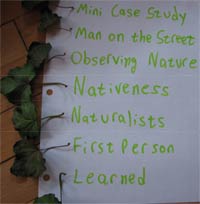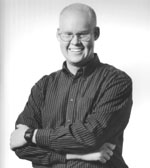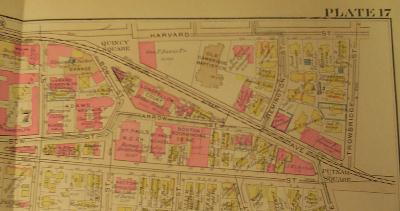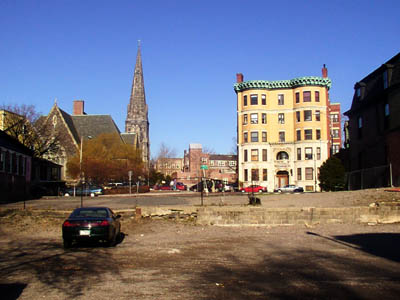| Class Site | Jay Silver |
A Case Study of Becoming an Explorer - Dec. 2007


 Comments
Comments
Insider Information Transforms the Landscape
 photo from alumweb.mit.edu |
Meet David Foxe
David took the future city class in 2002. He's a really interesting case because he's such an insider to his area, Bow and Arrow Street. He recently moved onto the area which he studied 5 years earlier. He is also a professional architect. So he really knows the area inside and out. His insider knowledge helped him to perceive totally different concepts in the area from anyone else. |
|
There is Nature in the city
During our interview, he summed up Anne's main point, "The point of The Granite Garden, much of Anne's work, and the work that came after it, was to reconnect the idea that there is nature in the city." His case study (screenshot right) was titled "Urban Slivers" |

|
| | |
|
A video I took right outside the bookstore without David |
 Map of Bow and Arrow St. from 1930  The same map as above... David shows me it's on the cover of a book in the bookstore |
| As David walks by the architecture book store he is thinking of the map that he had included in his case study (above, top right). He takes me into the bookstore and shows me that one of the books in the store has a map from the 1930's of this very location on its cover... it's from the fire insurance records. Minutes earlier, in looking for natural processes in the same location -- out front of the bookstore -- I don't imagine any maps at all. In fact, I don't even see the bookstore; its sign isn't very prominant. I see what happens to food if you throw it on the ground. | |
 Vacant Lot from David's Case Study |
An Empty Lot 5 Years Earlier
This empty lot was in David's report. They had moved a house that had been here. David brings me by the new house and shows me the address: 11 and 1/2... because it was placed between two other houses. |
|
The Same Lot Now
Now there's a theater there. David explains a little about the new theater: He was so precise about everything. But more importantly, when he looks at the new theater, he sees 15 years of empty lots, moved houses, and weathering copper. When I saw my friend perform in the new theater, all I saw was the performance. |
 A closeup shot of the new theater weathering |
|
||||
|
Invisible? Or Just Behind Closed Doors? Is There a Difference?
David swipes his card and takes me inside. He's a tutor at this residnece. This is the most concrete moment where what used to look like a brick wall now looks like a courtyard or painted hallways. He says "If you can know mentally that there's a space on the other side of a gate or the other side of a wall..." the rest was implied: What if you can know, mentally, that the invisible is there? It could totally change how you perceive a brick wall. How can I learn to do this without moving into an area? |
|

